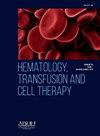阿扎胞苷、venetoclax和ruxolitinib联合治疗母细胞期骨髓增生性肿瘤
IF 1.6
Q3 HEMATOLOGY
引用次数: 0
摘要
目的在骨髓增生性肿瘤(MPN)的发展过程中,经常注意到向母细胞期(BP)的转变。因此,原发性骨髓纤维化(PMF)患者BP的发生率为-9%-13%,原发性血小板增多症(ET)患者BP的发生率为-1%-4%,真性红细胞增多症(PV)患者BP的发生率为-3%-7%。由于ET和PV的发展,也可以注意到向骨髓纤维化(MF)的转变。在这种情况下,PMF与后et - mf和后pv - mf的区分可能很困难。在治疗这些疾病时,根据病史和合并症采取个体化方法,可提高治疗效果。患者u.t.出生于1955年,于2019年6月在NCHBT登记,诊断为PMF。初次入院时,患者主诉过去6个月腹胀和体重严重减轻。检查发现脾肿大(204 × 85 mm)。血象:Hb - 151 g/L, WBC - 43 × 109/L, PLT - 779 × 109/L。骨髓组织学检查显示骨腔内充满纤维化基质,未见脂肪细胞。造血细胞弥漫性分散,细胞组成分为粒细胞目和巨核目。注意到红系目的减少。巨核细胞数量增加,急性多型,非典型细胞丰富。巨核细胞形成致密而稀疏的团块(可达6个细胞)和层状,注意到它们的骨旁定位。可见粗纤维胶原纤维化区。在分子遗传学检查中,JAK2V617F突变的等位基因负荷为92.694%。患者于2019年6月至2019年9月接受水肿(HY)治疗。由于血象未显示阳性动态,从2019年9月开始,每周3次肌肉注射干扰素(IFN) 300万单位。给药后,脾脏大小相对减小。从2020年3月开始,患者病情再次恶化。血图:Hb - 161 g/L, WBC - 34 × 109/L, PLT - 343 × 109/L。超声扫描脾脏大小200 × 84 mm。患者给予HY 1000mg p/天,同时给予干扰素。由于HY+IFN治疗,获得了积极的动力。血像图:Hb - 120 g/L, WBC - 4 × 109/L, PLT - 476 × 109/L;触诊脾脏+4 cm。HY+IFN治疗持续到2021年4月。从2021年4月起,继续单独使用HY治疗。2024年5月,患者病情恶化。骨髓形态学检查显示成原细胞16%,组织学检查显示成原细胞20%,成原细胞为髓系型。记录疾病向血压的转变。患者给予低剂量胞沙星2个疗程。由于未观察到阳性动态,骨髓中原细胞增加到78.6%,因此于7月开始使用阿扎胞苷(AZA) + Venetoclax (VEN)治疗,在第2个疗程后,记录了临床血液学缓解(骨髓图上原细胞为0.8%)。虽然患者血像和骨髓结果显示形态白血病无状态(MLFS),但由于近期脾脏大小急剧增加(197 × 78 mm)和腹部不适,在AZA+VEN治疗中添加Ruxolitinib (RUX) 15 mg。经治疗,患者脾体积减小,腹部不适消失。在对患者的检查中,进行了全血细胞计数和骨髓组织学检查。为确认骨髓纤维化,采用Gomori法行网状蛋白间质检查,检测一级和二级纤维化(M1-MF2)(评分0-3)。采用动态国际预后评分系统(DIPSS)进行评估,形成2分-中间-1分风险组。采用骨髓增生性肿瘤症状评定表(MPN-SAF-TSS)对患者的主诉进行评估。采用外周血实时荧光定量PCR法对JAK2V617F基因进行分子遗传学检测。用USS评估脾脏大小。AZA以100毫克的剂量皮下注射,每疗程7天。至今已举办6期课程。VEN按方案增加,处方剂量为400mg;根据细胞减少的情况,剂量减少200毫克,给药天数从28天到14天不等。RUX的处方剂量为每日15毫克。结果PMF转化为BP后,经2个疗程的低剂量化疗均未达到缓解。经AZA+VEN治疗后,患者达到MLFS。一段时间后,由于脾脏的生长,在AZA+VEN治疗方案中加入RUX,脾脏体积减小。结论AZA+VEN方案治疗BP-MF是有效的。 随后在治疗中加入RUX进一步提高了治疗的有效性,并导致患者一般状况的改善和投诉的减少。本文章由计算机程序翻译,如有差异,请以英文原文为准。
TREATMENT OF BLAST PHASE MYELOPROLIFERATIVE NEOPLASM WITH THE COMBINATION OF AZACITIDINE, VENETOCLAX AND RUXOLITINIB
Objective
In the development of Myeloproliferative Neoplasm (MPN), transformation to the Blast Phase (BP) is often noted. Thus, the incidence of BP in Primary Myelofibrosis (PMF) is -9%‒13%, in Essential Thrombocythemia (ET) -1%‒4%, and in Polycythemia Vera (PV) -3%‒7%. As a result of the development of ET and PV, transformation to Myelofibrosis (MF) can also be noted. In this case, differentiation of PMF from post-ET-MF and post-PV-MF can be difficult. In the treatment of these diseases, an individual approach according to the history and comorbidity, increases the effectiveness of treatment.
Methodology
Patient U.T., born in 1955, was registered at the NCHBT in June 2019 with a diagnosis of PMF. At the time of initial admission, the patient complained of abdominal distension and severe weight loss over the past 6-months. During examinations, a splenomegaly (204 × 85 mm) was found. In hemogram: Hb ‒ 151 g/L, WBC ‒ 43 × 109/L, PLT ‒ 779 × 109/L were. Histological examination of the bone marrow revealed that the bone cavities were filled with fibrotic stroma, no fat cells were detected. Hematopoietic cells were diffusely scattered, the cellular composition consisted of granulocytic and megakaryocytic orders. A reduction in the erythroid order was noted. The number of megakaryocytes was increased, acute polymorphism was noted, atypical forms were abundant. Megakaryocytes formed dense and sparse clumps (up to 6-cells) and layers, their paratrabecular localization was noted. Areas of coarse-fiber collagen fibrosis were noted. During molecular genetic examination, the allelic load of the JAK2V617F mutation was 92.694%. The patient was treated with Hydrea (HY)from June 2019 to September 2019. Since the hemogram did not show positive dynamics, Interferon (IFN) 3 million units was administered intramuscularly 3 times a week from September 2019. After this administration, a relative decrease in spleen size was noted. Starting from March 2020, the patient's condition deteriorated again. In hemogram: Hb ‒ 161 g/L, WBC ‒ 34 × 109/L, PLT ‒ 343 × 109/L were. The spleen size was 200 × 84 mm on Ultrasound Scan (USS). The patient was prescribed HY 1000 mg p/day along with IFN. Positive dynamics were achieved as a result of treatment with HY+IFN. Hemogram: Hb ‒ 120 g/L, WBC ‒ 4 × 109/L, PLT ‒ 476 × 109/L; spleen in palpation was +4 cm. Treatment with HY+IFN was continued until April 2021. From April 2021, treatment was continued with HY alone. In May 2024, the patient's condition worsened. Morphological examination of the bone marrow showed 16% blasts, histological examination showed 20% blasts, blasts were of myeloid type. Transformation of the disease to the BP was recorded. The patient was prescribed 2 courses of low-dose Cytosar. Since no positive dynamics were noted and blasts in the bone marrow increased to 78.6%, treatment with Azacitidine (AZA) + Venetoclax (VEN) was initiated in July, and after the 2nd course, clinical-hematological remission was recorded (blasts on myelogram were 0.8%). Although the patient's hemogram and bone marrow results showed Morphological Leukaemia-Free State (MLFS), Ruxolitinib (RUX) 15 mg was added to the treatment with AZA+VEN as a result of the recent sharp increase in spleen size (197 × 78 mm) and abdominal discomfort. As a result of the treatment, the patient's spleen size decreased, abdominal discomfort disappeared. During the examination of the patient, a complete blood count and histological examination of the bone marrow were performed. To confirm myelofibrosis, reticulin stroma examination was performed using the Gomori method, and first- and second-degree fibrosis (M1‒MF2) was detected (scale 0‒3). In assessment with the Dynamic International Prognostic Scoring System (DIPSS)-2 points-intermediate-1 risk group was formed. The patient's complaints were assessed with Myeloproliferative Neoplasm Symptom Assessment Form Total Symptom Score (MPN-SAF-TSS). Molecular-genetic examination of the JAK2V617F gene was performed using the real-time PCR method of peripheral blood. Spleen size was assessed with USS. AZA was prescribed subcutaneously at a dose of 100 mg for 7 days per course. 6 courses have been conducted so far. VEN was increased according to the scheme and prescribed at a dose of 400 mg; depending on cytopenia’s, the dose was reduced by 200 mg, and the number of days of administration varied from 28 to 14 days. RUX was prescribed at a dose of 15 mg daily.
Results
After transformation of PMF to BP, the patient did not achieve remission despite 2 courses of low dose cytosar treatment. After treatment with AZA+VEN, the patient achieved MLFS. After some time, due to the growth of the spleen, RUX was added to the AZA+VEN treatment protocol, and the spleen's size decreased.
Conclusion
The use of the AZA+VEN protocol was effective in BP-MF. The subsequent addition of RUX to the treatment further increased the effectiveness of the treatment and led to an improvement in the patient's general condition and a decrease in complaints.
求助全文
通过发布文献求助,成功后即可免费获取论文全文。
去求助
来源期刊

Hematology, Transfusion and Cell Therapy
Multiple-
CiteScore
2.40
自引率
4.80%
发文量
1419
审稿时长
30 weeks
 求助内容:
求助内容: 应助结果提醒方式:
应助结果提醒方式:


